Physical Address
304 North Cardinal St.
Dorchester Center, MA 02124
Physical Address
304 North Cardinal St.
Dorchester Center, MA 02124

Perched against Colorado's Sangre de Cristo Mountains, North America's tallest sand dunes hold secrets of their mysterious desert-alpine formation.
Like a surreal mirage rising from Colorado’s San Luis Valley, you’ll find North America’s tallest sand dunes nestled against the majestic Sangre de Cristo Mountains. You’re not in the Sahara, but rather at Great Sand Dunes National Park, where 750-foot dunes create an otherworldly landscape that defies expectations. This remarkable convergence of desert and alpine environments hasn’t happened by chance, and the forces that shaped this natural wonder continue to work their magic today.
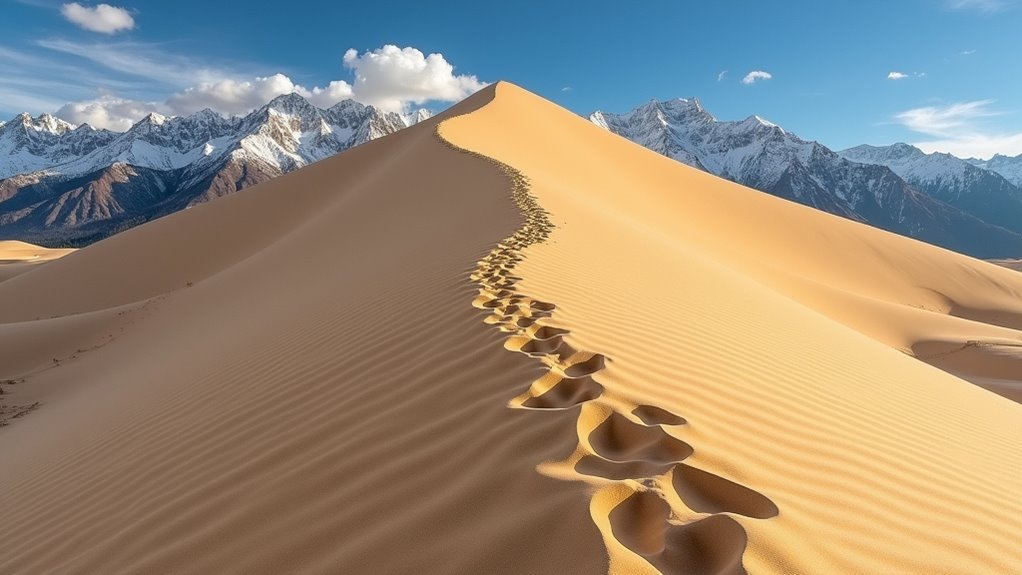
Nestled at the base of Colorado’s majestic Sangre de Cristo Mountains, the Great Sand Dunes National Park serves as North America’s most impressive dune system, reaching heights of up to 750 feet.
You’ll find an extraordinary landscape where approximately 1.2 cubic miles of sand have accumulated over tens of thousands of years, creating a 30-square-mile dune field. The formation resulted from ancient lake sediments, carried by predominant southwest winds toward the mountains.
Ancient lake sediments, swept by southwest winds over millennia, created this massive dune field spanning 30 square miles of Colorado wilderness.
The park’s unique geography comprises four distinct components: the mountain watershed, dune field, sand sheet, and sabkha. These remarkable formations began taking shape 440,000 years ago when ancient Lake Alamosa dried up.
What makes this natural masterpiece particularly remarkable is its diverse ecosystem mosaic. As you explore, you’ll encounter grasslands, wetlands, forests, alpine lakes, and tundra, all existing harmoniously alongside the towering dunes, while snow-capped 14,000-foot peaks create a stunning backdrop.
While many visitors admire the dunes’ natural splendor today, the path to national park status began modestly in 1932 when President Herbert Hoover designated the area as Great Sand Dunes National Monument.
You’ll find that local residents, particularly women from P.E.O., championed this initial protection in response to gold mining and concrete manufacturing threats.
The monument’s boundaries proved insufficient for long-term ecological preservation, leading to extensive negotiations in the late 20th century. These negotiations were crucial for protecting the 750-foot tall dunes that make the park a unique natural wonder.
President Clinton’s signing of the Great Sand Dunes National Park and Preserve Act in 2000 expanded protection by 70,000 acres.
The final transformation occurred on September 13, 2004, when Interior Secretary Gale Norton officially designated the 149,512-acre site as a national park and preserve, ensuring thorough protection of North America’s tallest dunes and their crucial water resources.
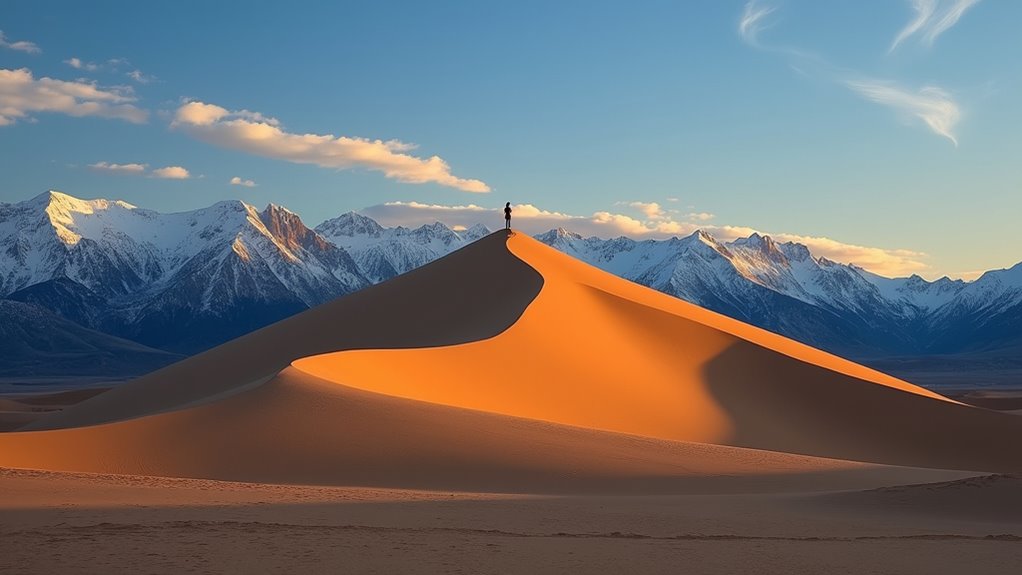
At the base of Colorado’s majestic Sangre de Cristo Mountains, the Great Sand Dunes present an extraordinary geological juxtaposition where desert meets alpine terrain.
You’ll find an intricate network of reversing, transverse, star, and barchan dunes, all shaped by opposing wind patterns at elevations between 7,500 to 8,200 feet.
The area’s unique composition reveals itself through diverse dune formations, with Medano Creek and seasonal streams actively recycling sand and sustaining the ecosystem.
Within the sand sheet area, you’ll observe distinctive parabolic and nebkha dunes, their shapes influenced by local vegetation patterns.
The dunes’ remarkable stability is maintained by opposing wind directions and an essential 7% subsurface moisture content, creating a delicate balance in this rare landscape where high-altitude desert seamlessly shifts into mountainous terrain.
Visitors should plan their explorations during early morning or evening hours, as summer sand temperatures can soar to a scorching 140°F.
Throughout the year, Great Sand Dunes National Park experiences distinct seasonal variations that shape your visiting experience.
Each season brings a unique transformation to Great Sand Dunes National Park, creating distinctly different adventures for visitors throughout the year.
You’ll find temperatures ranging from below freezing in winter to comfortable mid-70s during summer months, though the sand itself can reach a scorching 150°F.
Consider these key factors when planning your visit:
You’ll need to pack appropriately for these variations, with layers being essential during shoulder seasons and proper sun protection year-round.
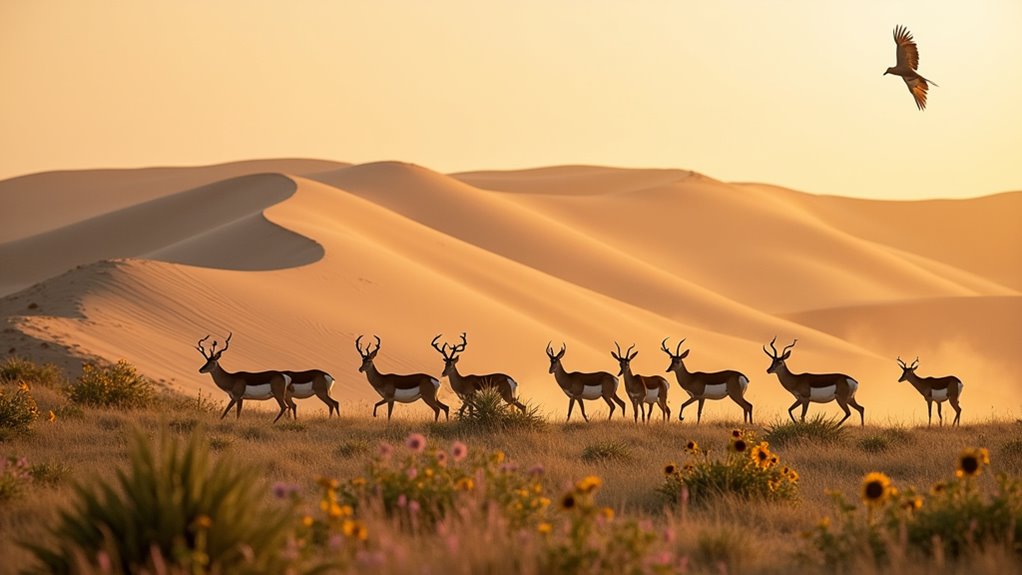
Great Sand Dunes National Park’s diverse ecosystems support a remarkable array of wildlife and plant species.
You’ll commonly spot mule deer throughout the park, while elk and pronghorn roam the grasslands. During migration seasons, you’ll witness an extraordinary spectacle as over 20,000 sandhill cranes descend upon the park’s wetlands. Ord’s kangaroo rats emerge at night to forage exclusively in the dunefield.
The park’s biodiversity includes more than 250 bird species, from burrowing owls to rufous hummingbirds.
Seven species of non-venomous reptiles inhabit the area, including uniquely adapted short-horned lizards that are half their normal size.
The surrounding vegetation zones, from wet meadows to desert shrubland, create essential habitats for wildlife.
These plant communities have adapted to sandy, alkaline conditions, supporting numerous species including the Rio Grande cutthroat trout in the park’s streams.
Whether you’re seeking heart-pumping adventures or tranquil exploration, the diverse recreational activities at this remarkable park cater to every visitor’s preferences.
The park’s unique landscape offers extraordinary opportunities for both adrenaline enthusiasts and nature lovers. Backcountry explorers can access remote areas via the Medano Pass Road, a challenging 22-mile unpaved route requiring 4WD vehicles. Essential tips for an unforgettable camping experience can enhance your visit to this outdoor paradise.
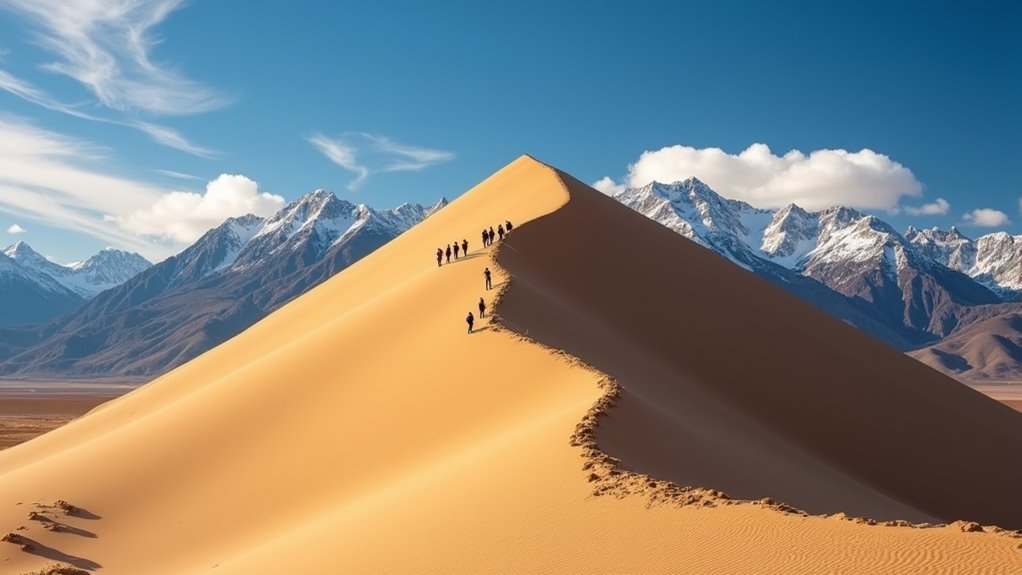
Among North America’s most awe-inspiring natural wonders, the towering dunes of southern Colorado stand as geological giants, reaching heights of up to 750 feet against the dramatic Sangre de Cristo Mountains.
You’ll find Star Dune, the park’s crown jewel, soaring to 741 feet and offering unparalleled panoramic views for those willing to undertake the challenging ascent.
To reach these magnificent summits, you’ll navigate across 30 square miles of wind-sculpted terrain. There aren’t any formal trails, so you’ll need to plot your own course through the soft sand. The park’s car camping options provide convenient bases for multi-day exploration.
It’s crucial to prepare for the 6-hour round-trip journey to High Dune, considering the altitude and weather conditions. Start from the Dunes Parking Lot, following Medano Creek bed for the initial stretch before tackling the impressive dune field.
Since its hotel, the Great Sand Dunes National Park and Preserve has protected over 100,000 acres of diverse ecosystems within Colorado’s San Luis Valley.
Under the Organic Act of 1916, the park’s administration focuses on preserving natural and historic objects for future generations whilst maintaining vital ecological balance.
You’ll find remarkable scientific significance throughout the preserve:
The park faces ongoing conservation challenges, with organisations like WNPA providing essential funding for wildlife tracking and ecosystem management. The area serves as a crucial habitat for an estimated 4,000 elk that roam the eastern San Luis Valley.
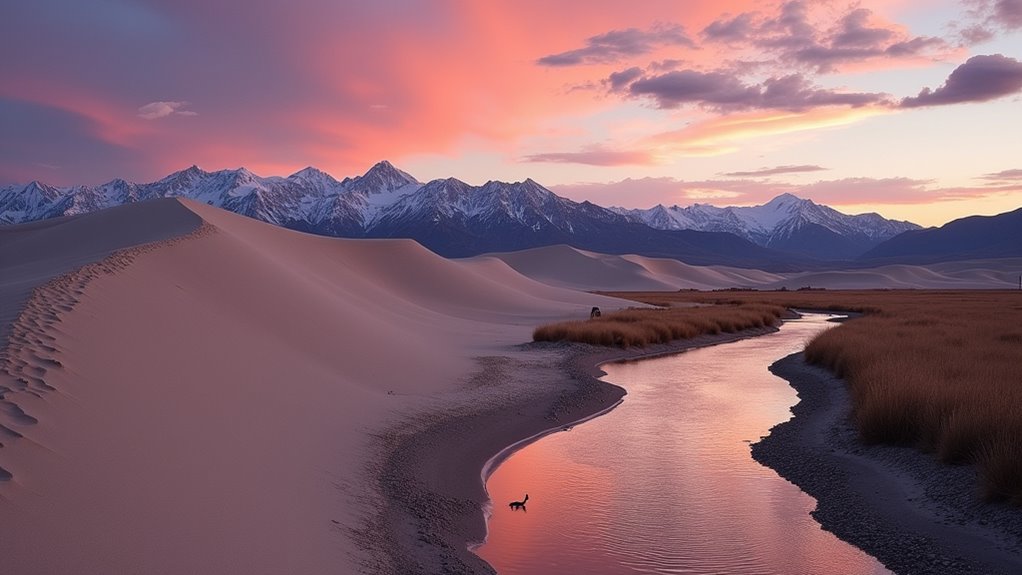
When planning a visit to the Great Sand Dunes National Park, you’ll find the park accessible throughout the year, with the visitor centre operating daily from 9:00 AM to 4:30 PM except for major holidays.
Summer offers ideal conditions with temperatures between 70-80°F, though you’ll need to exercise caution as sand surfaces can reach a scorching 150°F. The visitor center views provide spectacular vistas of the massive dunes from the back of the building. You’re advised to explore the dunes during early morning or evening hours.
The period from late May to early June presents peak flows at Medano Creek, offering unique recreational opportunities. Quick overnight camps are a great way to experience the park and discover the natural beauty of the dunes.
You’ll discover numerous activities to suit your interests, from sandboarding and sledding to challenging hikes up Star Dune. For equipment, you can rent specialised gear at the Oasis Store or Kristi Mountain Sports.
The nearby town of Alamosa provides additional amenities for your stay.
Standing amidst North America’s tallest dunes, you’ll witness nature’s remarkable contradictions: scorching sand beneath your feet whilst snow-capped peaks pierce the horizon. You’re traversing a landscape where alpine and desert ecosystems converge, creating an extraordinary tableau reminiscent of European coastal dunes, yet distinctly Colorado. Whether you’re sandboarding down massive dunes or observing rare species, Great Sand Dunes National Park offers a uniquely scientific and recreational experience.